Translocation of gut bacteria promotes tumor-associated mortality by inducing immune-activated renal damage
- PMID: 40404992
- PMCID: PMC12217037
- DOI: 10.1038/s44318-025-00458-5
Translocation of gut bacteria promotes tumor-associated mortality by inducing immune-activated renal damage
Abstract
Paraneoplastic syndrome represents severe and complex systemic clinical symptoms manifesting in multiple organs of cancer patients, but its cause and cellular underpinnings remain little explored. In this study, establishing a Drosophila model of paraneoplastic syndrome triggered by tumor transplantation, we found that the innate immune response, initiated by translocated commensal bacteria from a compromised intestine, significantly contributes to reduced lifespan in tumor-bearing hosts. Our data identify the renal system as a central hub of this paraneoplastic syndrome model, wherein the pericardial nephrocytes undergo severe damage due to an elevated immune response triggered by gut dysbiosis and bacterial translocation. This innate immune response-induced nephrocyte damage is a major contributor to reduced longevity in tumor-bearing hosts, as blocking the NF-kB/Imd pathway in nephrocytes or removing gut bacteria via germ-free derivation or antibiotic treatment ameliorates nephrocyte deterioration and extends the lifespan of tumor-bearing flies. Consistently, treatment with a detoxifying drug also extended the lifespan of the tumor hosts. Our findings highlight a critical role of the gut-kidney axis in the paraneoplastic complications observed in cancer-bearing flies, suggesting potential therapeutic targets for mitigating similar complications in cancer patients.
Keywords: Drosophila Tumor Model; Bacterial Translocation; Gut-kidney Axis; Innate Immunity; Paraneoplastic Glomerulopathy.
© 2025. The Author(s).
Conflict of interest statement
Disclosure and competing interests statement. The authors declare no competing interests.
Figures

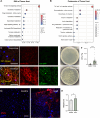
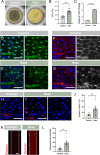
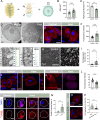
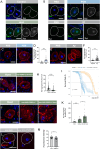


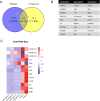
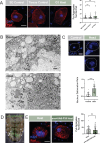
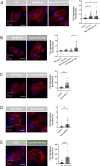

Similar articles
-
Role of the intestinal flora-immunity axis in the pathogenesis of rheumatoid arthritis-mechanisms regulating short-chain fatty acids and Th17/Treg homeostasis.Mol Biol Rep. 2025 Jun 21;52(1):617. doi: 10.1007/s11033-025-10714-w. Mol Biol Rep. 2025. PMID: 40544212 Review.
-
Immunosenescence, gut dysbiosis, and chronic kidney disease: Interplay and implications for clinical management.Biomed J. 2024 Apr;47(2):100638. doi: 10.1016/j.bj.2023.100638. Epub 2023 Jul 29. Biomed J. 2024. PMID: 37524304 Free PMC article. Review.
-
Synbiotics, prebiotics and probiotics for solid organ transplant recipients.Cochrane Database Syst Rev. 2022 Sep 20;9(9):CD014804. doi: 10.1002/14651858.CD014804.pub2. Cochrane Database Syst Rev. 2022. PMID: 36126902 Free PMC article.
-
Gut commensal bacteria influence colorectal cancer development by modulating immune response in AOM/DSS-treated mice.Microbiol Spectr. 2025 Jul;13(7):e0279224. doi: 10.1128/spectrum.02792-24. Epub 2025 May 16. Microbiol Spectr. 2025. PMID: 40377337 Free PMC article.
-
Systemic pharmacological treatments for chronic plaque psoriasis: a network meta-analysis.Cochrane Database Syst Rev. 2021 Apr 19;4(4):CD011535. doi: 10.1002/14651858.CD011535.pub4. Cochrane Database Syst Rev. 2021. Update in: Cochrane Database Syst Rev. 2022 May 23;5:CD011535. doi: 10.1002/14651858.CD011535.pub5. PMID: 33871055 Free PMC article. Updated.
Cited by
-
Inflammatory crosstalk: systemic gut-kidney interplay aggravates tumor host mortality.EMBO J. 2025 Jul;44(13):3547-3549. doi: 10.1038/s44318-025-00457-6. Epub 2025 May 22. EMBO J. 2025. PMID: 40404993 Free PMC article.
References
-
- Audard V, Larousserie F, Grimbert P, Abtahi M, Sotto J-J, Delmer A, Boue F, Nochy D, Brousse N, Delarue R et al (2006) Minimal change nephrotic syndrome and classical Hodgkin’s lymphoma: report of 21 cases and review of the literature. Kidney Int 69:2251–2260 - PubMed
-
- Azar L, Khasnis A (2013) Paraneoplastic rheumatologic syndromes. Curr Opin Rheumatol 25:44 - PubMed
-
- Balzan S, De Almeida Quadros C, De Cleva R, Zilberstein B, Cecconello I (2007) Bacterial translocation: overview of mechanisms and clinical impact. J Gastroenterol Hepatol 22:464–471 - PubMed
MeSH terms
Grants and funding
LinkOut - more resources
Full Text Sources
Medical

